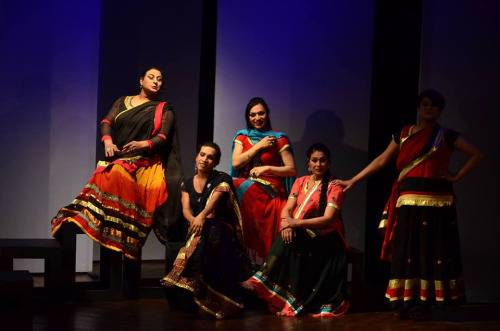In a society divided on the lines of Self and Other and in which the marginalized communities are still struggling to eke out their existence by creating pockets of resistance against the stereotypical outlook of their more privileged counterparts, being a member of the audience of Teesri Dhun, a performance depicting the struggles of transgender community in Pakistan, had been a startling but fulfilling experience.
The Third Tune no doubt touched the strings of heart through its disturbing yet highly entertaining and sensational performance at Alhamra Arts Council Lahore this Saturday. One of the highlights of the whole performance experience was the strong presence of the transgender community in the hall as members of the audience. The performance, in fact, not only enabled access to a marginalized community into the circles of mainstream audience but also bridged the imaginary gap between the two audiences created through the years of historical misapprehensions.
Clair Pamment and Shahnaz Khan took an important task of exposing the dark realities surrounding the lives of the transgender to the wider public. The effects of the performative actions were optimized by putting up a challenge to concepts and socio-cognitive constructs such as mardangi, sharam, and izzat.
The third tune brought the shadowy world of transgender community into light as well as suggested the change in mind-sets reflective of how we perceive things and phenomena by shutting doors to more inclusive alternatives. The effort allowed an interstitial space both for the socially acceptable and marginalized communities to get together under one roof and allow the ‘Other’ to become a part of their world by shedding all fears and ill wills.
Famously labeled as Khusra, Khwajasara, and Moorat in local parlance, transgenders are publically disinherited from their membership into the professed respectable groups of society. As a result, rather than living in the centre of communal circles, they are forced to construct a space at the margins in the form of small communities situated in mohallas. The performance unraveled how they are made to feel like an outsider each time they come in close proximity with other so-called normal communities.
Traversing through their life cycle from the woes of birth, rejection by their communities and their own families and suppression of childhood desires to the right to love and being loved and denial to respectable social institutions such as marriage, the performance portrayed how the transgender community has remained a victim to demeaning social behavior and sexual harassment over the years. A country with almost 2% children born with transgender qualities, their social exclusion is an offensive reality for many a sensitive minds.
From the point of view of performance dynamics, the space touched all the factual realities informing the theatrical life of the actors. Through the screening of clips from newspapers and legal practices, incidents related to police brutality, social stigmatization of and institutional impositions on the transgender community were highlighted. Ingenuous use of shadow screens aerated the soulful effects of the affected subjects on the stage. The unassuming and natural style of the performers, however, mitigated the intensity of the themes raised which otherwise might have been a bitter pill to swallow.
The performance made an effort to debunk the myth that transgenders have no capacity to work and carry out task in society as normal people and can only dance and sing. Through moving anecdotal acts, it was emphasized how studying in regular educational institutes and getting jobs in mainstream organizations are still what they can only dream of. For this reason they are still poverty stricken with little to no education and underprivileged in all walks of life.
The performers made a regular contact with the audience asking them various pungent and disturbing questions such as how and why a transgender child’s innocent games become the stigma of youth, why they are regarded as a sign of shame, disgrace and sex objects who are only suitable for entertaining people at different functions, why even after Supreme Court’s order of including the category of ‘third gender’ in the national identity card, they are still denied jobs and have to face identity crisis?
The performance successfully created a welter of emotions drawing the audiences in through its lyrical power and captivating dances. Teesri Dhun was an attempt to carve out an alternative space, an alternative discourse vying against the hegemony of gender discourse, itself divided and contested at many levels.






